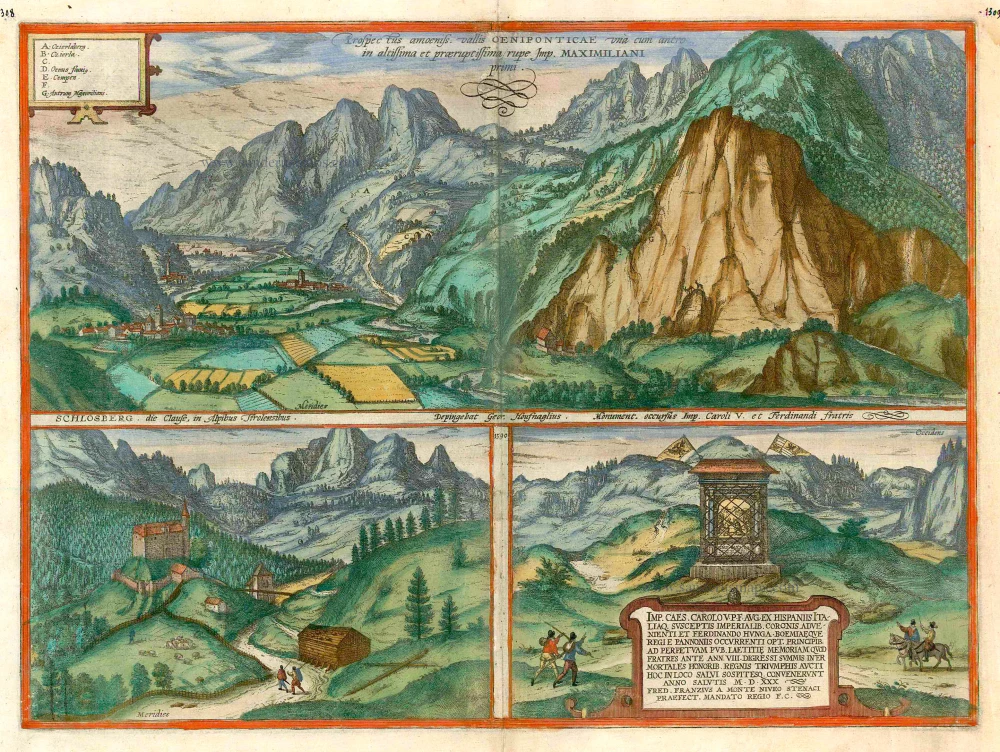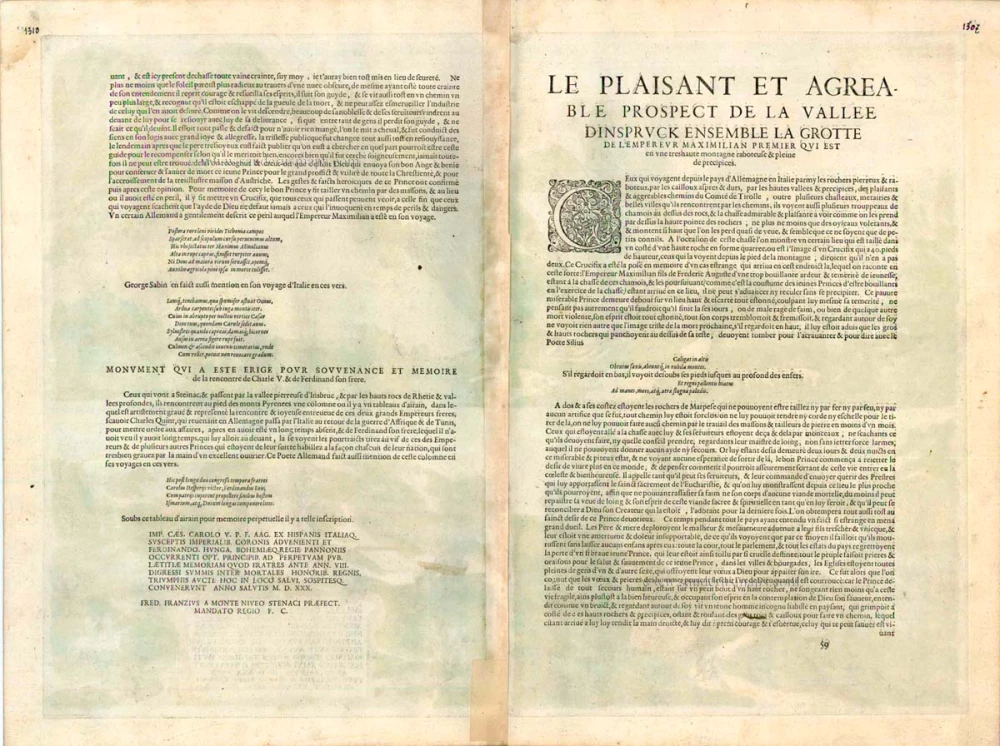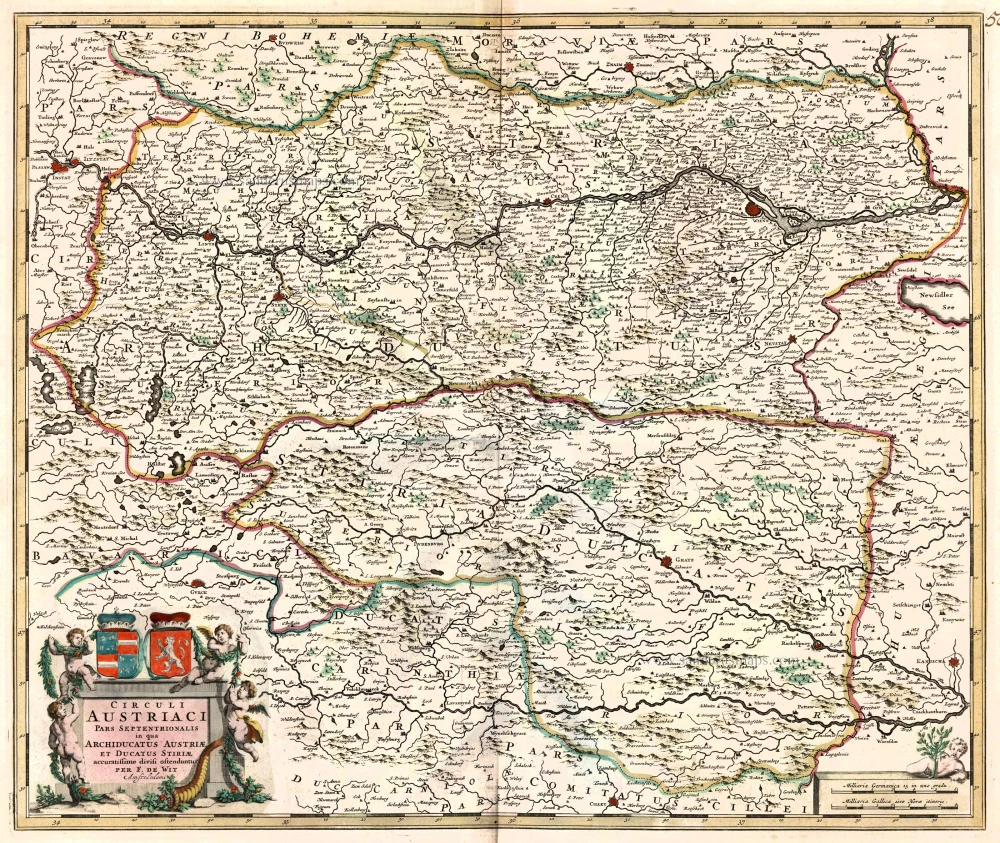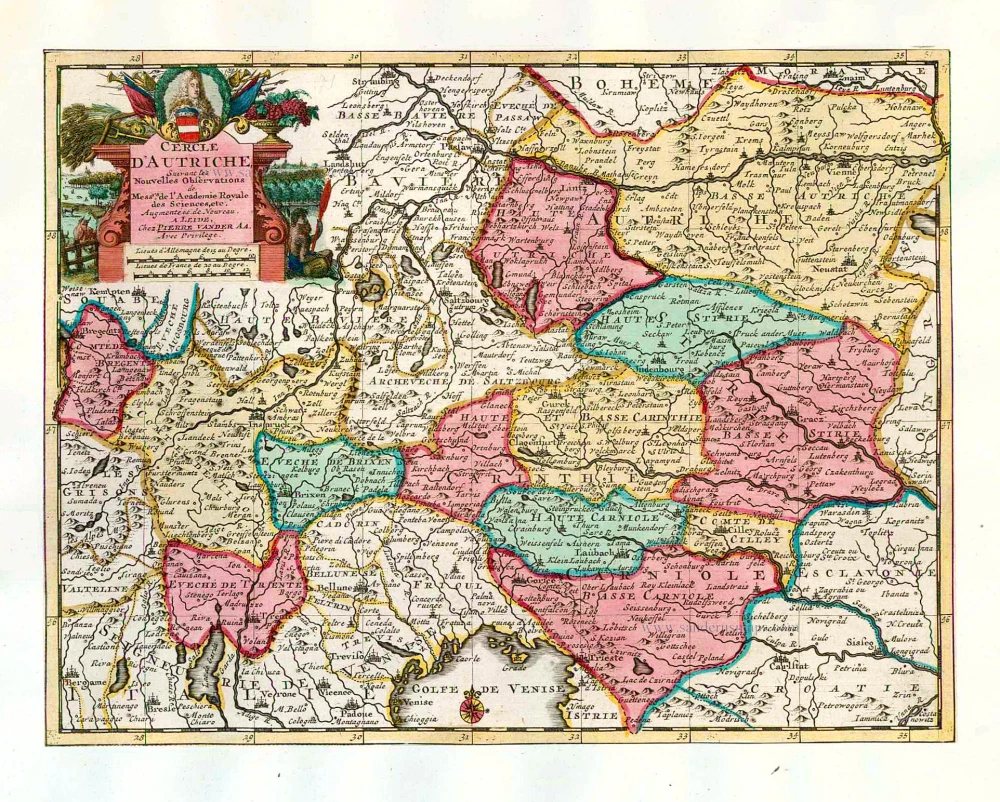The Innvalley; c. 1610
CAPTION: Prospect of the delightful Innsbruck Valley, together with the cave of Emperor Maximilian I on the very high and steep cliff.
CARTOUCHE BOTTOM RIGHT: Both noble rulers, the brothers Emperor Charles V, who came from Spain and Italy after his imperial coronation, and Ferdinand, King of Hungary and Bohemia, who came from Pannonia, were showered with the highest honours amongst mortals, with kingdoms and triumphs and met in this place and sound in 1530 to the general joy, after not having seen each other for eight years.
COMMENTARY BY BRAUN (on verso): "Those coming from Germany over the rugged cliffs of the Alps, passing through the deep and precipitous valleys and also along the pleasant Innsbruck and Tyrolean roads, will see a great many castles along the way and often herds of chamois on the rocky pinnacles, who leap to and fro high up on the rock face almost like light birds."
This three-part view presents the Inn Valley, a glacial valley that traverses the eastern Alps through which the river of the same name flows. The top illustration is seen from Völs, looking down upon Kematen (E) and Perfuss on the left-hand side of the valley and the right Zirl (B), with the ruins of Fragenstein (C) perched above it. The rock wall in the right half of the picture is the Martinswand, with the former fortress of Martinsklause (F) at its foot. The Martinswand wall, several hundred metres high, marks the end of the Hechenberg massif, part of the Nordkette range in the Karwendel Mountains. A cave in the rock face is known as the Kaiser Max Grotto (G), as Emperor Maximilian I took refuge in it when he got lost while hunting chamois, sheltering there until a peasant boy found him. The smaller illustration bottom left shows the castle of Schlossberg on the north side of Seefeld, an area inhabited even before Roman times. The castle was built in 1248 by the Counts of Andechs to protect the road to Scharnitz-Mittenwald. The viewpoint chosen in the engraving only allows a glimpse of the town behind the castle. From the end of the 14th century onwards, Seefeld's St Ostwald's church was an important pilgrimage destination. In 1583 Archduke Ferdinand II made a pilgrimage here on foot with an entourage of 2,000 people. The monument illustrated bottom right was erected in 1530 to commemorate the meeting of Emperor Charles V and Ferdinand, King of Hungary, on this site. (Taschen)
Prospectus amoeniss. vallis Oeniponticae una cum antro in altissima et praeruptissima rupe Imp. Maximiliani primi. [on sheet with:] Schlosberg. die Clause in Alpibus Tirolensibus. [and:] Monument. occursus Imp. Caroli V. et Ferdinandi fratis.
Item Number: 16685 Authenticity Guarantee
Category: Antique maps > Europe > Austria
Antique map with three views by Braun and Hogenberg: View of the Inn valley; view of the "Schlosberg" and a view of a monument for the emperor Carolus V. Engraved by G. Hoefnagel, 1590.
Title: Prospectus amoeniss. vallis Oeniponticae una cum antro in altissima et praeruptissima rupe Imp. Maximiliani primi. [on sheet with:] Schlosberg. die Clause in Alpibus Tirolensibus. [and:] Monument. occursus Imp. Caroli V. et Ferdinandi fratis.
Date of the first edition: 1596.
Date of this map: c. 1610.
Copper engraving, printed on paper.
Size (not including margins): 372 x 504mm (14.65 x 19.84 inches).
Verso: French text.
Condition: Contemporary coloured, excellent.
Condition Rating: A.
From: Théâtre des Principales Villes de tout l'Univers. Tome 5. c. 1610.
CAPTION: Prospect of the delightful Innsbruck Valley, together with the cave of Emperor Maximilian I on the very high and steep cliff.
CARTOUCHE BOTTOM RIGHT: Both noble rulers, the brothers Emperor Charles V, who came from Spain and Italy after his imperial coronation, and Ferdinand, King of Hungary and Bohemia, who came from Pannonia, were showered with the highest honours amongst mortals, with kingdoms and triumphs and met in this place and sound in 1530 to the general joy, after not having seen each other for eight years.
COMMENTARY BY BRAUN (on verso): "Those coming from Germany over the rugged cliffs of the Alps, passing through the deep and precipitous valleys and also along the pleasant Innsbruck and Tyrolean roads, will see a great many castles along the way and often herds of chamois on the rocky pinnacles, who leap to and fro high up on the rock face almost like light birds."
This three-part view presents the Inn Valley, a glacial valley that traverses the eastern Alps through which the river of the same name flows. The top illustration is seen from Völs, looking down upon Kematen (E) and Perfuss on the left-hand side of the valley and the right Zirl (B), with the ruins of Fragenstein (C) perched above it. The rock wall in the right half of the picture is the Martinswand, with the former fortress of Martinsklause (F) at its foot. The Martinswand wall, several hundred metres high, marks the end of the Hechenberg massif, part of the Nordkette range in the Karwendel Mountains. A cave in the rock face is known as the Kaiser Max Grotto (G), as Emperor Maximilian I took refuge in it when he got lost while hunting chamois, sheltering there until a peasant boy found him. The smaller illustration bottom left shows the castle of Schlossberg on the north side of Seefeld, an area inhabited even before Roman times. The castle was built in 1248 by the Counts of Andechs to protect the road to Scharnitz-Mittenwald. The viewpoint chosen in the engraving only allows a glimpse of the town behind the castle. From the end of the 14th century onwards, Seefeld's St Ostwald's church was an important pilgrimage destination. In 1583 Archduke Ferdinand II made a pilgrimage here on foot with an entourage of 2,000 people. The monument illustrated bottom right was erected in 1530 to commemorate the meeting of Emperor Charles V and Ferdinand, King of Hungary, on this site. (Taschen)






